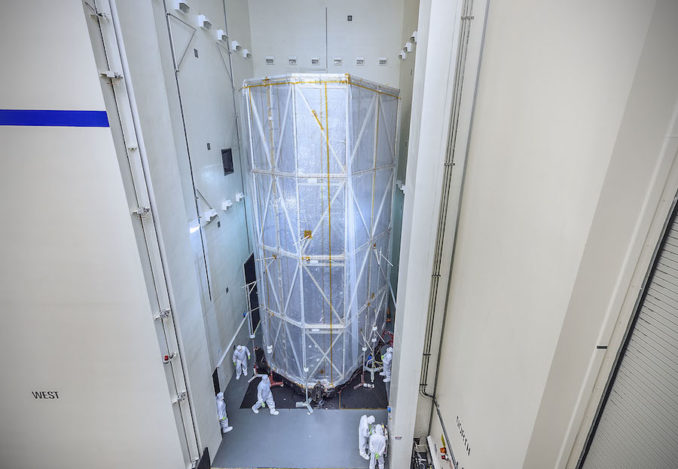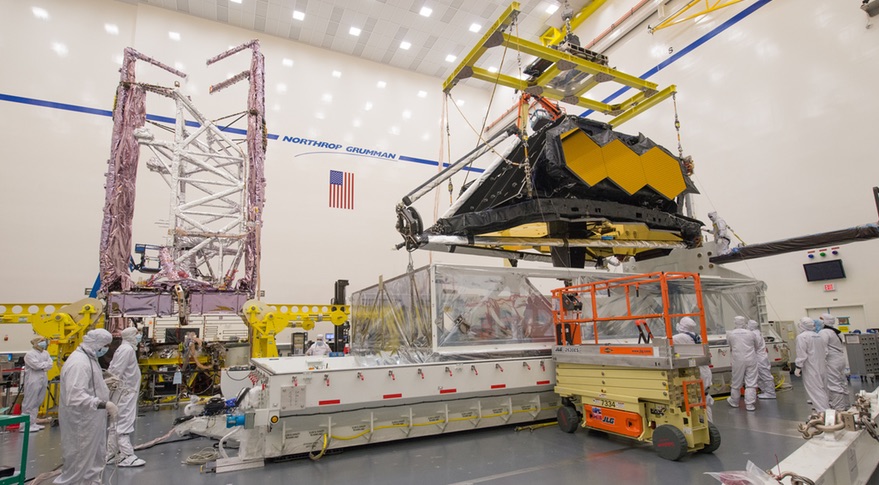JWST beset by another problem as Northrop Grumman revamps training
From Stephen Clark, Spaceflightnow, May 8th, 2018:
Engineers working on the James Webb Space Telescope, which had its launch delayed to 2020 earlier this year, recently discovered another problem during testing at the observatory’s prime contractor Northrop Grumman in Southern California.Teams at Northrop Grumman inspecting JWST’s spacecraft element after an acoustic test found fastening hardware had come loose, according to a NASA statement issued Friday. The spacecraft module, which will be mated to the observatory’s telescope section before launch, includes propulsion and power systems, plus a five-layer sunshield to keep the observatory’s telescope in shadow while in space.
NASA said in a statement Friday that the loose hardware discovered after the acoustic test was designed to fasten the sunshield’s membrane covers in place during launch.
- The James Webb Space Telescope’s spacecraft element pictured during acoustic testing.
- Credit: NASA/Chris Gunn

In a statement, Robinson stressed the importance of ground testing to catch such problems.
“This is an example of why space systems are thoroughly and rigorously tested on the ground to uncover imperfections and fix them prior to launch,” Robinson said.
First reported by Space News, the discovery of the loose fasteners comes after NASA decided in late March to delay JWST’s launch from no earlier than March 2019 until around May 2020, and a prior schedule slip announced last year that pushed back the launch from October 2018 to 2019.
“It’s not terrible news, but it’s not good news, either,” Robinson said last week in a meeting of the National Academies’ Space Studies Board, according to Space News. Robinson said the fastening hardware included “washers and screws.”
When NASA announced the latest JWST launch delay March 27, officials described multiple concerns with the observatory’s spacecraft element, which was built by Northrop Grumman and is now undergoing environmental testing to ensure it can withstand the rigors of spaceflight.
Before the acoustic test, engineers put the spacecraft through a mechanical shock test to simulate the loads it will encounter when the observatory separates from its Ariane 5 launcher. The acoustic test subjected the spacecraft to the intense sound of a launch, while the vibration test — up next in the spacecraft test campaign — will simulate the shaking of a rocket ride.
“More time is needed to test and integrate the highly complex sunshield and spacecraft section at Northrop Grumman,” said Thomas Zurbuchen, associate administrator of NASA’s science mission directorate, in a briefing with reporters March 27. “ That is taking longer to complete, and there are also a few mistakes that happened. ”
The flagship mission will be the most ambitious astronomical observatory ever launched, building on a quarter-century of discoveries made by NASA’s famous Hubble Space Telescope. Originally proposed more than 20 years ago, the James Webb Space Telescope has been redesigned to expand its observing power and overcome numerous technical hurdles, ballooning costs from an original projection below $1 billion to more than $10 billion, a figure that includes planned launch and operations expenses, along with European and Canadian contributions.
The new observatory will be stationed nearly a million miles (1.5 million kilometers) from Earth, using a 21.3-foot (6.5-meter) mirror and four science instruments hidden behind a thermal sunshield to peer into the distant universe, studying the turbulent aftermath of the Big Bang, the formation of galaxies and the environments of planets around other stars.
Named for the NASA administrator who led the agency in the 1960s, the James Webb Space Telescope has already cost NASA $7.3 billion.
With the launch delay to 2020, the cost to develop the mission could rise above an $8 billion limit set by lawmakers to cover Webb’s development. If that happens, the mission must be reviewed and reauthorized by Congress. The rest of the funding covers launch costs borne by the European Space Agency for Webb’s ride into space on an Ariane 5 rocket, plus operating expenses after launch.
NASA officials identified several problems attributed to mistakes by the Northrop Grumman team: a damaged transducer that was incorrectly powered during testing, requiring replacement, valves in the spacecraft’s propulsion system that had to be replaced after they were improperly cleaned, and a catalyst bed heater that was overstressed at the wrong voltage. Engineers also found tears in the sunshield membranes during a deployment test to check how the thermal barrier will unfold to the size of a tennis court once in space, and it took longer than expected to deploy, fold and stow the sunshield.
Workers at Northrop Grumman will connect Webb’s spacecraft and telescope elements for combined testing before shipping the observatory to its launch base in French Guiana. JWST will launch with its sunshield, solar panels, antenna and telescope mirrors folded up for launch, then will go through a weeks-long process to deploy the parts on the way to its observing station at the L2 Lagrange point nearly a million miles (1.5 million kilometers) from Earth.
The telescope has completed its standalone testing at NASA’s Goddard Space Flight Center in Greenbelt, Maryland, and at the Johnson Space Center in Houston. It was delivered to Northrop Grumman’s Redondo Beach facility earlier this year. NASA said in March it would install more oversight over JWST in the future, including direct interaction with Northrop Grumman’s president and chief operating officer. NASA also planned to dispatch a project manager to Northrop Grumman’s factory in Southern California on a permanent basis, along with additional NASA spacecraft integration and test experts during critical operations. NASA also added daily and weekly schedule reviews with Northrop Grumman, which will also revamp its management structure. Northrop Grumman is also making personnel changes and updating procedures, officials said in March.
An independent review board chaired by Thomas Young, a space industry veteran who served as an executive at Lockheed Martin and as mission director of NASA’s Viking Mars landers, will complete a report examining JWST’s technical, schedule and budget issues around the end of May.The review will help NASA confirm a new launch date, now expected around May 2020, and a new cost estimate for the mission.
And from Space News, May 3rd , 2018:
WASHINGTON As an independent review of NASA’s James Webb Space Telescope continues, the project is dealing with a new problem discovered in recent testing of the spacecraft.
In a presentation at a meeting of the National Academies’ Space Studies Board here May 3, Greg Robinson, the JWST program director at NASA Headquarters, said some “screws and washers” appear to have come off the spacecraft during recent environmental testing at a Northrop Grumman facility in Southern California.
- The optical element of NASA’s James Webb Space Telescope is removed from a shipping container in a Northrop Grumman clean room in March. The spacecraft element, including the folded-up sunshield, is at left prior to undergoing acoustic testing.
- Credit: Northrop Grumman

This latest incident comes as an independent review board, chartered by NASA in late March after announcing a one-year delay in JWST’s launch because of other technical issues, is in the midst of its analysis of the mission and its launch readiness. That review, led by retired aerospace executive and former NASA Goddard director Tom Young, is scheduled to be completed at the end of the month.
“It was a no-brainer to put an independent review board in place,” Thomas Zurbuchen, NASA associate administrator for science, said at the Space Studies Board meeting May 2. The board, he said, will provide an independent look at the status of the mission and identify what needs to be done to ensure the mission will be successful. Zurbuchen said there would be a “little bit of a pause” after the board delivers its final report, in part because of a prior commitment by Young in early June that makes him unavailable for discussions about the report or additional work.
He said NASA will start briefing Congress and others about the report, and the agency’s response, in late June. That report will allow NASA to refine a launch date of approximately May 2020 that it announced March 27.
Robinson believed there was margin in the revised development schedule to maintain that date.






